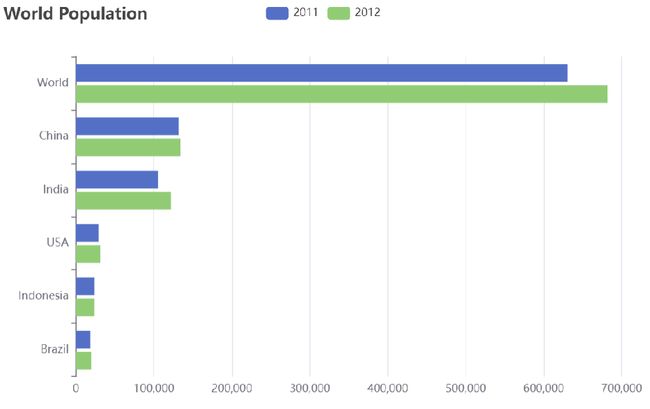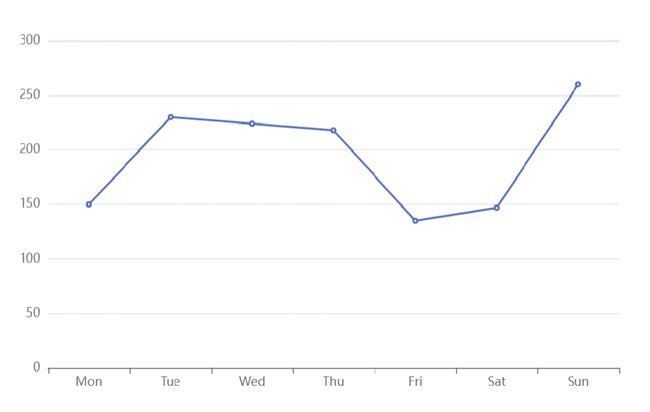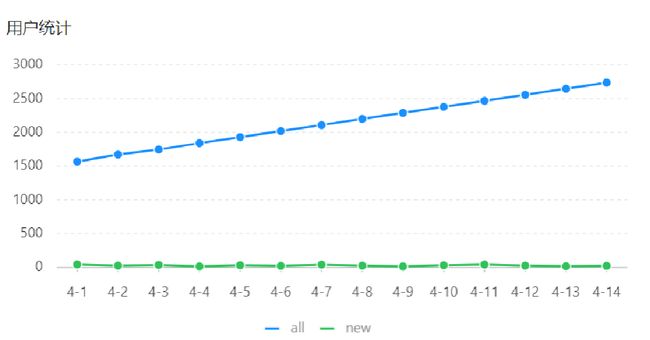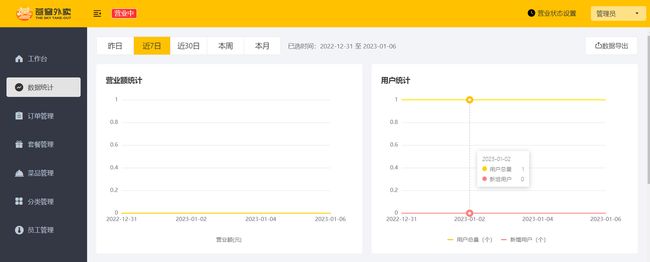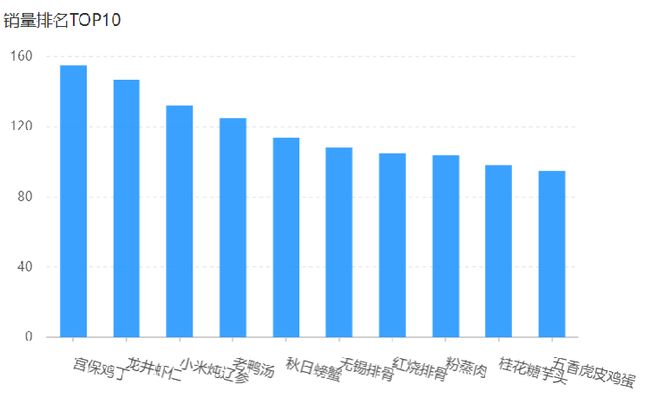SpringBoot+SSM项目实战 苍穹外卖(11) Apache ECharts
继续上一节的内容,本节学习Apache ECharts,实现营业额统计、用户统计、订单统计和销量排名Top10功能。
数据统计效果图:
目录
- Apache ECharts
-
- 入门案例
- 营业额统计
- 用户统计
- 订单统计
- 销量排名Top10
Apache ECharts
Apache ECharts 是一款基于 Javascript 的数据可视化图表库,提供直观,生动,可交互,可个性化定制的数据可视化图表。
常见效果:柱形图、饼形图、折线图
入门案例
Apache Echarts官方提供的快速入门
实现步骤:
1). 引入echarts.js 文件(当天资料已提供)
2). 为 ECharts 准备一个设置宽高的 DOM
3). 初始化echarts实例
4). 指定图表的配置项和数据
5). 使用指定的配置项和数据显示图表
DOCTYPE html>
<html>
<head>
<meta charset="utf-8" />
<title>EChartstitle>
<script src="echarts.js">script>
head>
<body>
<div id="main" style="width: 600px;height:400px;">div>
<script type="text/javascript">
// 基于准备好的dom,初始化echarts实例
var myChart = echarts.init(document.getElementById('main'));
// 指定图表的配置项和数据
var option = {
title: { // 图表标题
text: 'ECharts 入门示例'
},
tooltip: {},
legend: { // 图例
data: ['销量']
},
xAxis: { // x轴
data: ['衬衫', '羊毛衫', '雪纺衫', '裤子', '高跟鞋', '袜子']
},
yAxis: {},
series: [ // y轴数据
{
name: '销量',
type: 'bar', // 指定柱状图类型
data: [5, 20, 36, 10, 10, 20]
}
]
};
// 使用刚指定的配置项和数据显示图表。
myChart.setOption(option);
script>
body>
html>
使用Echarts,重点在于研究当前图表所需的数据格式。通常是需要后端提供符合格式要求的动态数据,然后响应给前端来展示图表。
营业额统计
营业额统计基于折现图来展现,并且按照天来展示的,不管光标放在哪个点上,就会把具体的数值展示出来。并且日期并不是固定写死的,是由上边时间选择器来决定。比如选择是近7天、或者是近30日,或者是本周,就会把相应这个时间段之内的每一天日期通过横坐标展示。
业务规则:营业额指订单状态为已完成的订单金额合计、基于可视化报表的折线图展示营业额数据,X轴为日期,Y轴为营业额、根据时间选择区间,展示每天的营业额数据
通过上述原型图,设计出对应的接口。具体返回数据一般由前端来决定,前端展示图表,具体折现图对应数据是什么格式,是有固定的要求的。所以后端需要去适应前端,它需要什么格式的数据,我们就给它返回什么格式的数据。
根据接口定义设计对应的VO,在sky-pojo模块,TurnoverReportVO.java已定义。
@Data
@Builder
@NoArgsConstructor
@AllArgsConstructor
public class TurnoverReportVO implements Serializable {
//日期,以逗号分隔,例如:2022-10-01,2022-10-02,2022-10-03
private String dateList;
//营业额,以逗号分隔,例如:406.0,1520.0,75.0
private String turnoverList;
}
根据接口定义创建admin.ReportController:
/**
* 报表
*/
@RestController
@RequestMapping("/admin/report")
@Slf4j
@Api(tags = "统计报表相关接口")
public class ReportController {
@Autowired
private ReportService reportService;
/**
* 营业额数据统计
*
* @param begin
* @param end
* @return
*/
@GetMapping("/turnoverStatistics")
@ApiOperation("营业额数据统计")
public Result<TurnoverReportVO> turnoverStatistics(
@DateTimeFormat(pattern = "yyyy-MM-dd")
LocalDate begin,
@DateTimeFormat(pattern = "yyyy-MM-dd")
LocalDate end) {
return Result.success(reportService.getTurnover(begin, end));
}
}
创建ReportServiceImpl实现类,实现getTurnover方法:
@Service
@Slf4j
public class ReportServiceImpl implements ReportService {
@Autowired
private OrderMapper orderMapper;
/**
* 根据时间区间统计营业额
* @param begin
* @param end
* @return
*/
public TurnoverReportVO getTurnover(LocalDate begin, LocalDate end) {
//dateList用于存放从begin到end范围内的每天的日期
List<LocalDate> dateList = new ArrayList<>();
dateList.add(begin);
while (!begin.equals(end)){
begin = begin.plusDays(1);//日期计算,获得指定日期后1天的日期
dateList.add(begin);
}
List<Double> turnoverList = new ArrayList<>();
for (LocalDate date : dateList) { //计算每个日期该天的营业额
//查询data日期对应的营业额 要求状态为"已完成"的订单金额合计
//给data日期加上时分秒 因为数据库里存的是LocalDateTime类型 而data是LocalDate类型
LocalDateTime beginTime = LocalDateTime.of(date, LocalTime.MIN);//LocalTime.MIN对应一天开始的时刻'00:00'
LocalDateTime endTime = LocalDateTime.of(date, LocalTime.MAX);//LocalTime.MAX对应一天结束的时刻'23:59:59.999999999'
Map map = new HashMap();
map.put("status", Orders.COMPLETED);
map.put("begin",beginTime);
map.put("end", endTime);
Double turnover = orderMapper.sumByMap(map);
turnover = turnover == null ? 0.0 : turnover;
turnoverList.add(turnover);
}
//数据封装
return TurnoverReportVO.builder()
.dateList(StringUtils.join(dateList,",")) //指定分隔符拼接list里的字符串
.turnoverList(StringUtils.join(turnoverList,","))
.build();
}
}
在OrderMapper接口声明sumByMap方法:
/**
* 根据动态条件统计营业额
* @param map
*/
Double sumByMap(Map map);
在OrderMapper.xml文件中编写动态SQL:
<select id="sumByMap" resultType="java.lang.Double">
select sum(amount) from orders
<where>
<if test="status != null">
and status = #{status}
</if>
<if test="begin != null">
and order_time <![CDATA[>]]>= #{begin}
</if>
<if test="end != null">
and order_time <![CDATA[<]]>= #{end}
</if>
</where>
</select>
这里日期的大于等于和小于等于因为是占位符,原本需要用一些占位符代替:
>=写成>=
<=写成<=
我使用了CDATA区,这种写法也可以,可以参考:java特殊文件 属性文件properties和XML文件
进入数据统计模块查看近7日营业额统计
进入开发者模式,查看返回数据
用户统计
通过折线图来展示用户的数量,蓝色线代表的是用户总量,绿色线代表的是新增用户数量,具体到每一天。所以说用户统计主要统计两个数据,一个是总的用户数量,另外一个是新增用户数量。
业务规则:基于可视化报表的折线图展示用户数据,X轴为日期,Y轴为用户数、根据时间选择区间,展示每天的用户总量和新增用户量数据
根据用户统计接口的返回结果设计VO,在sky-pojo模块,UserReportVO.java已定义
@Data
@Builder
@NoArgsConstructor
@AllArgsConstructor
public class UserReportVO implements Serializable {
//日期,以逗号分隔,例如:2022-10-01,2022-10-02,2022-10-03
private String dateList;
//用户总量,以逗号分隔,例如:200,210,220
private String totalUserList;
//新增用户,以逗号分隔,例如:20,21,10
private String newUserList;
}
ReportController中创建userStatistics方法:
/**
* 用户数据统计
* @param begin
* @param end
* @return
*/
@GetMapping("/userStatistics")
@ApiOperation("用户数据统计")
public Result<UserReportVO> userStatistics(
@DateTimeFormat(pattern = "yyyy-MM-dd") LocalDate begin,
@DateTimeFormat(pattern = "yyyy-MM-dd") LocalDate end){
return Result.success(reportService.getUserStatistics(begin,end));
}
在ReportServiceImpl实现类中实现getUserStatistics方法:
/**
* 根据时间区间统计用户数量
* @param begin
* @param end
* @return
*/
public UserReportVO getUserStatistics(LocalDate begin, LocalDate end) {
//dateList用于存放从begin到end范围内的每天的日期
List<LocalDate> dateList = new ArrayList<>();
dateList.add(begin);
while (!begin.equals(end)){
begin = begin.plusDays(1);//日期计算,获得指定日期后1天的日期
dateList.add(begin);
}
List<Integer> newUserList = new ArrayList<>(); //新增用户数
List<Integer> totalUserList = new ArrayList<>(); //总用户数
for (LocalDate date : dateList) {//计算每个日期该天的新增用户数量和总用户数量
//给data日期加上时分秒 因为数据库里存的是LocalDateTime类型 而data是LocalDate类型
LocalDateTime beginTime = LocalDateTime.of(date, LocalTime.MIN);//LocalTime.MIN对应一天开始的时刻'00:00'
LocalDateTime endTime = LocalDateTime.of(date, LocalTime.MAX);//LocalTime.MAX对应一天结束的时刻'23:59:59.999999999'
//新增用户数量 select count(id) from user where create_time >= ? and create_time <= ?
Integer newUser = getUserCount(beginTime, endTime);
//总用户数量 select count(id) from user where create_time <= ?
Integer totalUser = getUserCount(null, endTime);
newUserList.add(newUser);
totalUserList.add(totalUser);
}
return UserReportVO.builder()
.dateList(StringUtils.join(dateList,","))
.newUserList(StringUtils.join(newUserList,","))
.totalUserList(StringUtils.join(totalUserList,","))
.build();
}
在ReportServiceImpl实现类中创建私有方法getUserCount:
/**
* 根据时间区间统计用户数量
* @param beginTime
* @param endTime
* @return
*/
private Integer getUserCount(LocalDateTime beginTime, LocalDateTime endTime) {
Map map = new HashMap();
map.put("begin",beginTime);
map.put("end", endTime);
return userMapper.countByMap(map);
}
在UserMapper接口中声明countByMap方法:
/**
* 根据动态条件统计用户数量
* @param map
* @return
*/
Integer countByMap(Map map);
在UserMapper.xml文件中编写动态SQL:
<select id="countByMap" resultType="java.lang.Integer">
select count(id) from user
<where>
<if test="begin != null">
and create_time >= #{begin}
if>
<if test="end != null">
and create_time <= #{end}
if>
where>
select>
进入数据统计模块,查看近7日用户统计
进入开发者模式,查看返回数据
订单统计
通过一个折现图来展现订单,蓝色的线代表的是订单总数,而下边这根绿色的线代表的是有效订单数,即状态是已完成的订单,分别反映的是每一天的数据。上面还有3个数字,分别是订单总数、有效订单、订单完成率,它指的是整个时间区间之内总的数据。
业务规则:有效订单指状态为 “已完成” 的订单、基于可视化报表的折线图展示订单数据,X轴为日期,Y轴为订单数量、根据时间选择区间,展示每天的订单总数和有效订单数、展示所选时间区间内的有效订单数、总订单数、订单完成率,订单完成率 = 有效订单数 / 总订单数 * 100%
根据订单统计接口的返回结果设计VO,在sky-pojo模块,OrderReportVO.java已定义
@Data
@Builder
@NoArgsConstructor
@AllArgsConstructor
public class OrderReportVO implements Serializable {
//日期,以逗号分隔,例如:2022-10-01,2022-10-02,2022-10-03
private String dateList;
//每日订单数,以逗号分隔,例如:260,210,215
private String orderCountList;
//每日有效订单数,以逗号分隔,例如:20,21,10
private String validOrderCountList;
//订单总数
private Integer totalOrderCount;
//有效订单数
private Integer validOrderCount;
//订单完成率
private Double orderCompletionRate;
}
在ReportController中根据订单统计接口创建orderStatistics方法:
/**
* 订单数据统计
* @param begin
* @param end
* @return
*/
@GetMapping("/ordersStatistics")
@ApiOperation("用户数据统计")
public Result<OrderReportVO> orderStatistics(
@DateTimeFormat(pattern = "yyyy-MM-dd")
LocalDate begin,
@DateTimeFormat(pattern = "yyyy-MM-dd")
LocalDate end){
return Result.success(reportService.getOrderStatistics(begin,end));
}
在ReportServiceImpl实现类中实现getOrderStatistics方法:
/**
* 根据时间区间统计订单数量
* @param begin
* @param end
* @return
*/
public OrderReportVO getOrderStatistics(LocalDate begin, LocalDate end){
//dateList用于存放从begin到end范围内的每天的日期
List<LocalDate> dateList = new ArrayList<>();
dateList.add(begin);
while (!begin.equals(end)){
begin = begin.plusDays(1);//日期计算,获得指定日期后1天的日期
dateList.add(begin);
}
//每天订单总数集合
List<Integer> orderCountList = new ArrayList<>();
//每天有效订单数集合
List<Integer> validOrderCountList = new ArrayList<>();
for (LocalDate date : dateList) {//计算每个日期该天的总订单数和有效订单数
//给data日期加上时分秒 因为数据库里存的是LocalDateTime类型 而data是LocalDate类型
LocalDateTime beginTime = LocalDateTime.of(date, LocalTime.MIN);//LocalTime.MIN对应一天开始的时刻'00:00'
LocalDateTime endTime = LocalDateTime.of(date, LocalTime.MAX);//LocalTime.MAX对应一天结束的时刻'23:59:59.999999999'
//查询每天的总订单数 select count(id) from orders where order_time >= ? and order_time <= ?
Integer orderCount = getOrderCount(beginTime, endTime, null);
//查询每天的有效订单数 select count(id) from orders where order_time >= ? and order_time <= ? and status = ?
Integer validOrderCount = getOrderCount(beginTime, endTime, Orders.COMPLETED);
orderCountList.add(orderCount);
validOrderCountList.add(validOrderCount);
}
//时间区间内的总订单数
Integer totalOrderCount = orderCountList.stream().reduce(Integer::sum).get();
//时间区间内的总有效订单数
Integer validOrderCount = validOrderCountList.stream().reduce(Integer::sum).get();
//订单完成率
Double orderCompletionRate = 0.0;
if(totalOrderCount != 0){
orderCompletionRate = validOrderCount.doubleValue() / totalOrderCount;
}
return OrderReportVO.builder()
.dateList(StringUtils.join(dateList, ","))
.orderCountList(StringUtils.join(orderCountList, ","))
.validOrderCountList(StringUtils.join(validOrderCountList, ","))
.totalOrderCount(totalOrderCount)
.validOrderCount(validOrderCount)
.orderCompletionRate(orderCompletionRate)
.build();
}
在ReportServiceImpl实现类中提供私有方法getOrderCount:
/**
* 根据时间区间统计指定状态的订单数量
* @param beginTime
* @param endTime
* @param status
* @return
*/
private Integer getOrderCount(LocalDateTime beginTime, LocalDateTime endTime, Integer status) {
Map map = new HashMap();
map.put("status", status);
map.put("begin",beginTime);
map.put("end", endTime);
return orderMapper.countByMap(map);
}
在OrderMapper接口中声明countByMap方法:
/**
*根据动态条件统计订单数量
* @param map
*/
Integer countByMap(Map map);
在OrderMapper.xml文件中编写动态SQL:
<select id="countByMap" resultType="java.lang.Integer">
select count(id) from orders
<where>
<if test="status != null">
and status = #{status}
if>
<if test="begin != null">
and order_time >= #{begin}
if>
<if test="end != null">
and order_time <= #{end}
if>
where>
select>
进入数据统计模块查看近7日订单统计
进入开发者模式,查看返回数据
销量排名Top10
销量排名指的就是菜品和套餐销售的数量排名。通过柱形图来展示销量排名,这些销量是按照降序来排列,并且只需要统计销量排名前十的商品。
业务规则:根据时间选择区间,展示销量前10的商品(包括菜品和套餐)、基于可视化报表的柱状图降序展示商品销量、此处的销量为商品销售的份数
根据销量排名接口的返回结果设计VO,在sky-pojo模块,SalesTop10ReportVO.java已定义
@Data
@Builder
@NoArgsConstructor
@AllArgsConstructor
public class SalesTop10ReportVO implements Serializable {
//商品名称列表,以逗号分隔,例如:鱼香肉丝,宫保鸡丁,水煮鱼
private String nameList;
//销量列表,以逗号分隔,例如:260,215,200
private String numberList;
}
在ReportController中根据销量排名接口创建top10方法:
/**
* 销量排名统计
* @param begin
* @param end
* @return
*/
@GetMapping("/top10")
@ApiOperation("销量排名统计")
public Result<SalesTop10ReportVO> top10(
@DateTimeFormat(pattern = "yyyy-MM-dd") LocalDate begin,
@DateTimeFormat(pattern = "yyyy-MM-dd") LocalDate end){
return Result.success(reportService.getSalesTop10(begin,end));
}
在ReportServiceImpl实现类中实现getSalesTop10方法:
/**
* 查询指定时间区间内的销量排名top10
* @param begin
* @param end
* @return
* */
public SalesTop10ReportVO getSalesTop10(LocalDate begin, LocalDate end){
//给data日期加上时分秒 因为数据库里存的是LocalDateTime类型 而data是LocalDate类型
LocalDateTime beginTime = LocalDateTime.of(begin, LocalTime.MIN);//LocalTime.MIN对应一天开始的时刻'00:00'
LocalDateTime endTime = LocalDateTime.of(end, LocalTime.MAX);//LocalTime.MAX对应一天结束的时刻'23:59:59.999999999'
List<GoodsSalesDTO> goodsSalesDTOList = orderMapper.getSalesTop10(beginTime, endTime);
String nameList = StringUtils.join(goodsSalesDTOList.stream().map(GoodsSalesDTO::getName).collect(Collectors.toList()),",");
String numberList = StringUtils.join(goodsSalesDTOList.stream().map(GoodsSalesDTO::getNumber).collect(Collectors.toList()),",");
return SalesTop10ReportVO.builder()
.nameList(nameList)
.numberList(numberList)
.build();
}
在OrderMapper接口中声明getSalesTop10方法:
/**
* 查询商品销量排名
* @param begin
* @param end
*/
List<GoodsSalesDTO> getSalesTop10(LocalDateTime begin, LocalDateTime end);
在OrderMapper.xml文件中编写动态SQL:
<select id="getSalesTop10" resultType="com.sky.dto.GoodsSalesDTO">
select od.name name,sum(od.number) number from order_detail od ,orders o
where od.order_id = o.id
and o.status = 5
<if test="begin != null">
and order_time >= #{begin}
if>
<if test="end != null">
and order_time <= #{end}
if>
group by name
order by number desc
limit 0, 10
select>
这个select需要注意,返回的是List类型,并且查询语句也容易写错。
查看近30日销量排名Top10统计
进入开发者模式,查看返回数据


